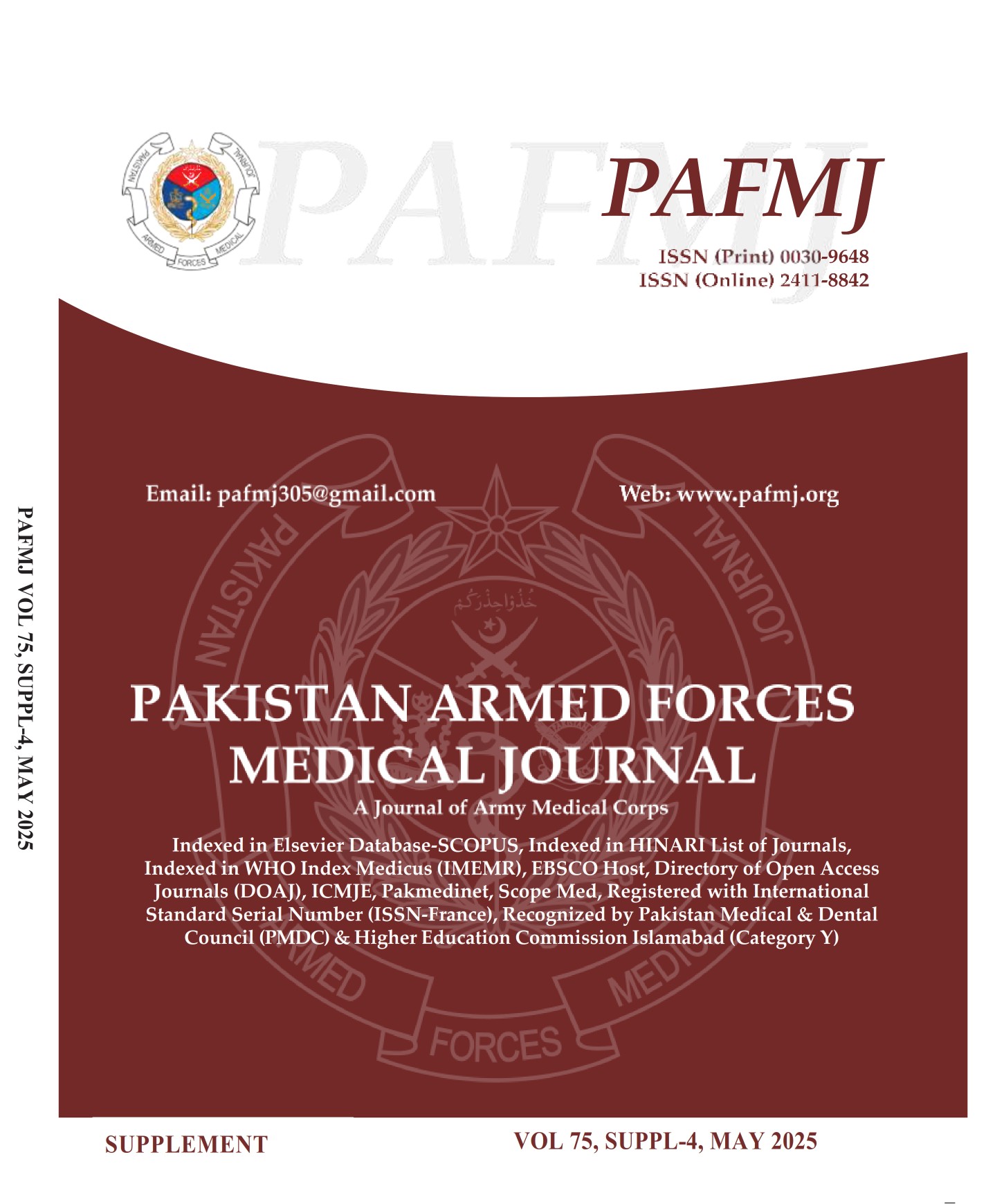Comparison of Rmi (Risk Malignancy Index) and Simple Rules Risk Model In Evaluation of Adnexal Masses Taking Histopathology As Gold Standard
DOI:
https://doi.org/10.51253/pafmj.v75iSUPPL-4.6771Keywords:
Adnexal mass; Benign masses; Transvaginal ultrasoundAbstract
Objective: To compare ultrasound grounded International Ovarian Tumor Analysis (IOTA) prediction models, specifically, the ADNEX models, the Simple Rules (SRs) and the Risk of Malignancy Index (RMI), for the adnexal masses’ diagnosis before any surgical intervention
Study Design: Cross-sectional analytical study
Place and Duration of Study: Obstetrics and Gynecology Department. Pakistan Emirates Military Hospital, Rawalpindi, Pakistan from Aug 2019 to Jun 2020.
Methodology: Five hundred and twenty-four patients took part in this cross-sectional Analytical study. All findings on ultrasound were evaluated and prognostic models were used. Histopathology findings were used as standard for comparison. Diagnostic performances of the prediction models were assessed by estimating sensitivities, ROC curves, negative predictive values and positive predictive values, specificities, diagnostic odds ratios and negative and positive likelihood ratios.
Results: The ROC under curves (AUC) areas for ADNEX models were 0.94 (0.92-0.96, 95% CI) with CA125 and 0.94 (0.91-0.96, 95% CI) without CA-125 for RMI I-III It was expressively advanced than AUC: 0.83 (CI95%, 0.80 to 0.86), 0.82 (CI95%, 0.78 to 0.86 and 0.87 (CI95% 0.83 to 0.90) (all p <0.0001). The CA-125 had a cut-off point of 10% in ADNEX model had the maximum precision (CI: 95%, 0.87 to 0.97) equated to other models. The SR model achieved 0.93 (95% CI 0.86 to 0.97) sensitivity and 0.86 (95% CI 0.82 to 0.89) specificity when not diagnosed was classified as definite (11.7%) malignant.
Conclusions: ADNEX and Simple rules risk models were excellent for characterizing adnexal masses better than RMI in Pakistani patients.
Downloads
References
Tug N, Yassa M, Sargın MA, Taymur BD, Sandal K. Preoperative discriminating performance of the IOTA-ADNEX model and comparison with Risk of Malignancy Index: an external validation in a non-gynecologic oncology tertiary center.Eur J Gynaecol Oncol. 2020; 41(2): 200-207.
Mulder EE, Gelderblom ME, Schoot D, Vergeldt TF, Nijssen DL, Piek JM. External validation of Risk of Malignancy Index compared to IOTA Simple Rules. Acta Radiol. 2021 May; 62(5): 673-678. https://doi: 10.1177/0284185120933990.
Thomassin-Naggara I, Poncelet E, Jalaguier-Coudray A, Guerra A, Fournier LS, Stojanovic S, et al. Ovarian-Adnexal Reporting Data System Magnetic Resonance Imaging (O-RADS MRI) Score for Risk Stratification of Sonographically Indeterminate Adnexal Masses. JAMA Netw Open. 2020 Jan 3; 3(1): e1919896. https://doi: 10.1001/jamanetworkopen.2019.19896.
Atri M, Alabousi A, Reinhold C, Akin EA, Benson CB, Bhosale PR, et al. ACR Appropriateness Criteria® Clinically Suspected Adnexal Mass, No Acute Symptoms. J Am Coll Radiol. 2019 May; 16(5S): S77-S93.
https://doi: 10.1016/j.jacr.2019.02.011.
Rocha RM, Barcelos IDES. Practical Recommendations for the Management of Benign Adnexal Masses. Rev Bras Ginecol Obstet. 2020 Sep; 42(9): 569-576. English.
https://doi: 10.1055/s-0040-1714049.
Shetty M. Imaging and Differential Diagnosis of Ovarian Cancer. Semin Ultrasound CT MR. 2019 Aug; 40(4): 302-318. https://doi: 10.1053/j.sult.2019.04.002.
Lycke M, Ulfenborg B, Kristjansdottir B, Sundfeldt K. Increased Diagnostic Accuracy of Adnexal Tumors with A Combination of Established Algorithms and Biomarkers. J Clin Med. 2020; 9(2): 299. Published 2020 Jan 21.
https://doi:10.3390/jcm9020299
Saleh AM, Al-Saygh F, Abushama M, Ahmed B. The Role of Three-Dimensional Ultrasound in Gynecology. Res Women Health. 2019; 1(1): 4-12.
Weinberg, Robert S. Horn TS. Playing through pain and injury: psychosocial considerations. J Clinic Sport Psych. 2013; 7(3): 41-59.
Rai R, Bhutia PC, Tshomo U. Clinicopathological profile of adnexal masses presenting to a tertiary-care hospital in Bhutan. South Asian J Cancer. 2019; 8(3): 168-172.
https://doi:10.4103/sajc.sajc_303_18
Mehta SS, Bhatt A, Glehen O. Cytoreductive Surgery and Peritonectomy Procedures. Indian J Surg Oncol. 2016; 7(2): 139-151.https://doi:10.1007/s13193-016-0505-5
Jeong SY, Park BK, Lee YY, Kim TJ. Validation of IOTA-ADNEX Model in Discriminating Characteristics of Adnexal Masses: A Comparison with Subjective Assessment. J Clin Med. 2020; 9(6): 2010. Published 2020 Jun 26.
https://doi:10.3390/jcm9062010
Knafel A, Banas T, Nocun A, Wiechec M, Jach R, Ludwin A et al. The Prospective External Validation of International Ovarian Tumor Analysis (IOTA) Simple Rules in the Hands of Level I and II Examiners. Ultraschall Med. 2016 Oct; 37(5): 516-523. English.
https://doi: 10.1055/s-0034-1398773.
Auekitrungrueng R, Tinnangwattana D, Tantipalakorn C, Charoenratana C, Lerthiranwong T, Wanapirak C, et al. Comparison of the diagnostic accuracy of International Ovarian Tumor Analysis simple rules and the risk of malignancy index to discriminate between benign and malignant adnexal masses. Int J Gynaecol Obstet. 2019 Sep; 146(3): 364-369.
https://doi: 10.1002/ijgo.12891.
Thomassin-Naggara I, Belghitti M, Milon A, Abdel Wahab C, Sadowski E, Rockall AG. O-RADS MRI score: analysis of misclassified cases in a prospective multicentric European cohort. Eur Radiol. 2021 Dec; 31(12): 9588-9599.
https://doi: 10.1007/s00330-021-08054-x.
Salvador S, Scott S, Glanc P, Eiriksson L, Jang JH, Sebastianelli A, et al. Guideline No. 403: Initial Investigation and Management of Adnexal Masses. J Obstet Gynaecol Can. 2020 Aug; 42(8): 1021-1029.e3.
https://doi: 10.1016/j.jogc.2019.08.044.
Atallah GA, Abd Aziz NH, Teik CK, Shafiee MN, Kampan NC. New Predictive Biomarkers for Ovarian Cancer. Diagnostics (Basel). 2021 Mar 7; 11(3): 465.
https://doi: 10.3390/diagnostics11030465.
Perrone MG, Luisi O, De Grassi A, Ferorelli S, Cormio G, Scilimati A. Translational Theragnosis of Ovarian Cancer: where do we stand? Curr Med Chem. 2020; 27(34): 5675-5715. https://doi: 10.2174/0929867326666190816232330.
Mikhaleva LM, Davydov AI, Patsap OI, Mikhaylenko EV, Nikolenko VN, Neganova ME, et al. Malignant Transformation and Associated Biomarkers of Ovarian Endometriosis: A Narrative Review. Adv Ther. 2020 Jun; 37(6): 2580-2603. https://doi: 10.1007/s12325-020-01363-5.
Downloads
Published
Issue
Section
License
Copyright (c) 2025 Durr e Shahwar, Abeera Choudhry, Khalida ., Zareen Tahir, Insha Tahir, Sundas Arif

This work is licensed under a Creative Commons Attribution-NonCommercial 4.0 International License.















